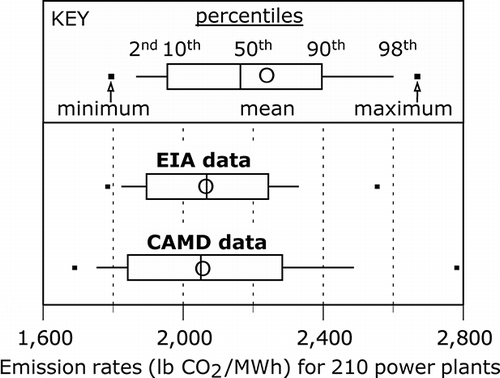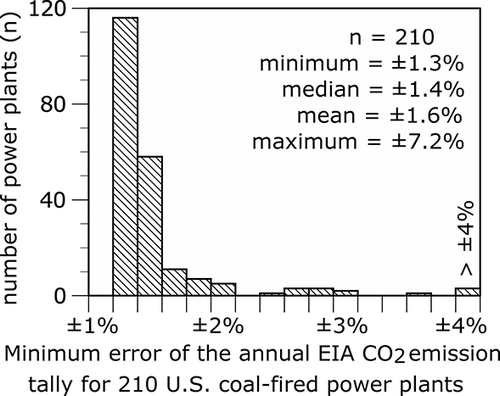Figures & data
Figure 1. Annual CO2 emissions measured by CEMS (CAMD data) vary by ±10.8% (two times the standard deviation) from CO2 emissions calculated from fuel consumption (EIA data) for 210 U.S. coal-fired power plants during 2009. The percent difference was calculated according to: 100 × (CAMD – EIA)/[(CAMD + EIA)/2].
![Figure 1. Annual CO2 emissions measured by CEMS (CAMD data) vary by ±10.8% (two times the standard deviation) from CO2 emissions calculated from fuel consumption (EIA data) for 210 U.S. coal-fired power plants during 2009. The percent difference was calculated according to: 100 × (CAMD – EIA)/[(CAMD + EIA)/2].](/cms/asset/0a4e4976-40aa-4135-873f-b3af6434d71a/uawm_a_833146_o_f0001g.gif)
Figure 2. Annual CO2 emission rates calculated from CAMD and EIA data for 210 U.S. power plants during 2009 show similar mean values (2,062 and 2,074 lb CO2/MWh, respectively), but more variable CAMD emission rates compared to EIA emission rates (standard deviations of 178 and 137 lb CO2/MWh, respectively).

Figure 3. Attenuation bias due to CAMD measurement error is shown by comparison of best-fit lines where (a) EIA CO2 emission rates are used to predict CAMD rates, and (b) CAMD CO2 emission rates are used to predict EIA rates (data are for 210 U.S. coal-fired power plants during 2009). Although both lines share the same significance and correlation (P < 0.001, R 2 = 0.61), note the larger standard error for (a) and that the slope for (b) is closer to zero.


